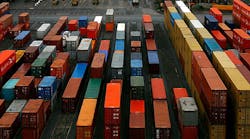China’s monthly trade surplus with the U.S. rose to a record in June, underlining the imbalance at the heart of an escalating trade war between the world’s two largest economies.
The trade surplus with the U.S. stood at $28.97 billion, the highest in any month in data back to 1999. Exports climbed to $42.62 billion, also a high, the customs administration said on Friday.
While multiple factors will have influenced the data, including a rush by some manufacturers to sell goods before tariffs imposed this month hit, there’s little sign that the U.S. deficit with China will improve any time soon. As tax cuts fuel the U.S. expansion and a slowing Chinese economy may cool domestic demand, the almost-$340 billion annual gap will continue to provide the backdrop to the standoff.
“The record bilateral surplus shows exactly that the U.S. economy is robust while that of China is weakening," said Wang Jian, a Shanghai-based economist at Shenwan Hongyuan Group Co. “China’s domestic investment is softening due to funding strains, while consumption is not particularly strong either.”
Both China and the U.S. imposed 25% tariffs on $34 billion of the others’ imports on July 6, and Beijing has vowed to fight back against proposed tariffs on an additional $200 billion in Chinese goods.
What Our Economists Say
“The effects of the trade war on China’s exports are likely to be more pronounced from July,” said Bloomberg’s China economist Fielding Chen. “The hit to growth from the current U.S. tariffs though, is likely to be limited.”
The yuan’s decline in June was the worst in any month since 1994, dropping more than 3% against the dollar. While that ought to help exporters in the longer run, the yuan’s fall now is a sign of growing concern as the trade war arrives at a time when the economy is already slowing. President Xi Jinping may ultimately have to choose between softening his multiyear campaign to control debt levels, or letting growth dip below the target of 6.5%.
Overall exports to all nations rose 11.3% in June in dollar terms, while imports climbed 14.1%, below a forecast of 21.3%, leaving a trade surplus of $41.61 billion. The trade surplus with the European Union rose to the highest level since 2011, while the deficit with Japan shrank.
The trade data comes ahead of the gross domestic product report for the second quarter, which should give a more complete picture of how the world’s second biggest economy did in the first half of this year. That is scheduled for release on Monday, with economists forecasting a slight slowing of the quarterly growth pace to 6.7% from 6.8%.
"Both imports and exports have seen robust growth in the first half as companies front-load orders ahead of the trade war, resulting in nice-looking year-to-date trade data, but the momentum is hardly sustainable in the future," said Ding Shuang, chief economist of Greater China & North Asia at Standard Chartered Bank Ltd. in Hong Kong, one of the most accurate trade data forecasters this month. He said China still has solid domestic demand despite the decline in import growth.
In a separate report, China’s broadest measure of new credit expanded in June, with further evidence of a contraction in shadow banking emerging. Aggregate financing stood at 1.18 trillion yuan (US$176 billion) in June, the People’s Bank of China said on Friday.
Investment, factory output and retail sales growth all slowed in May. The tighter credit tap will also subtract from infrastructure and property investment for the rest of the year, as local governments cut borrowing and property developers have less access to shadow financing channels.
"Import growth declined due to fewer purchases of oil and iron ore last month, indicating industrial production is easing moderately, especially in upper-stream sectors such as smelting and chemicals," said Gai Xinzhe, analyst at Bank of China Institute of International Finance in Beijing. That’s a "worrisome sign" for the second half of this year as domestic demand was already showing signs of a slowdown in previous months, he said.
By Bloomberg News



